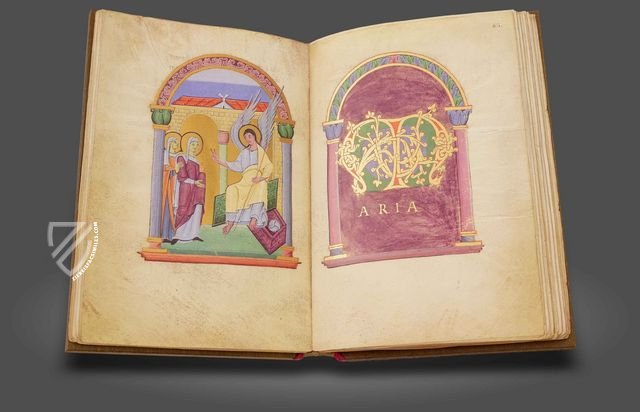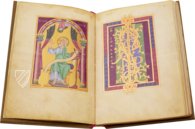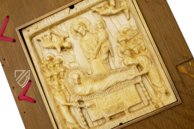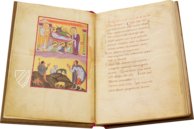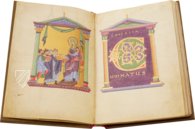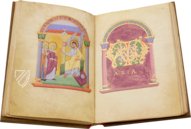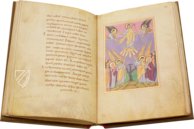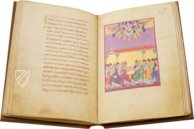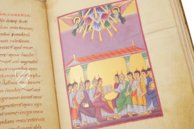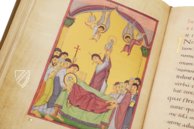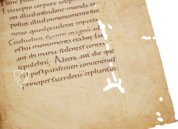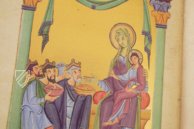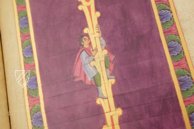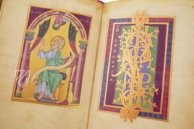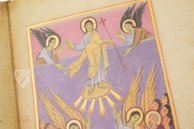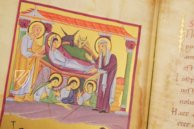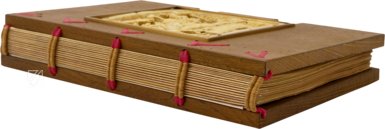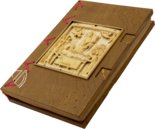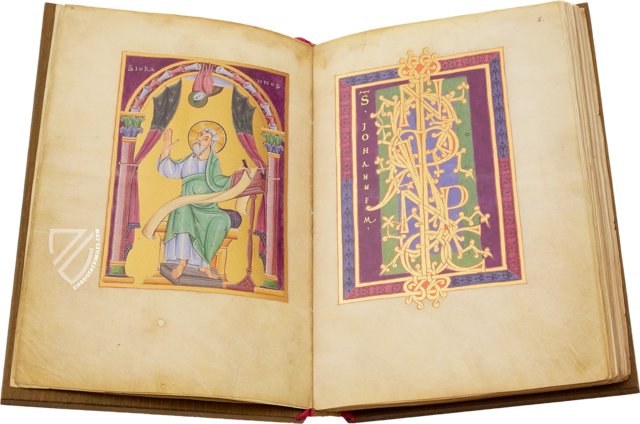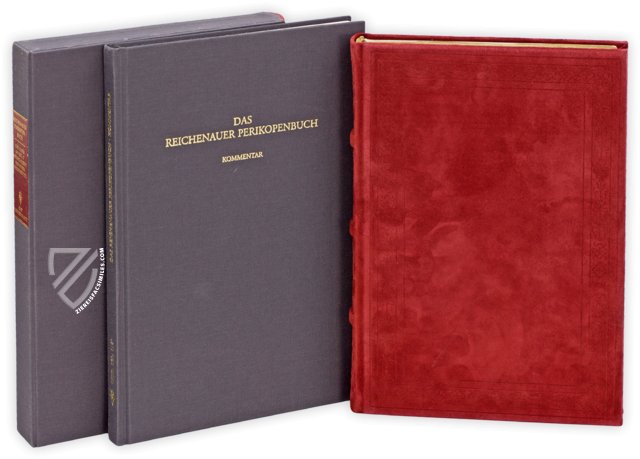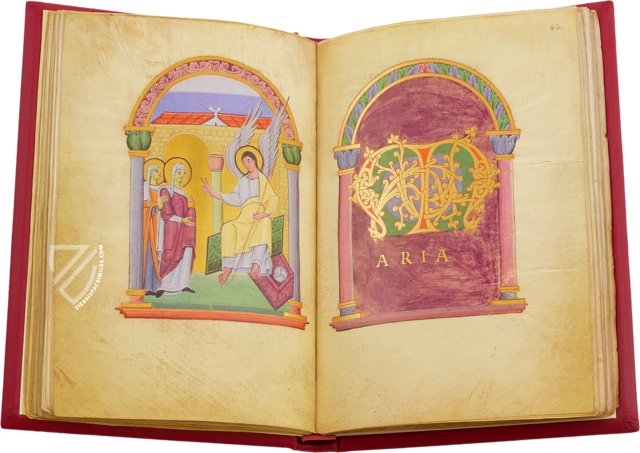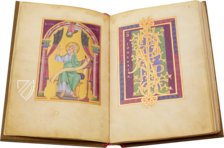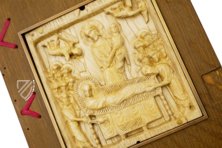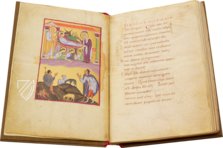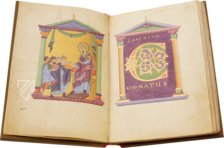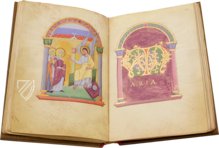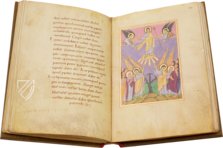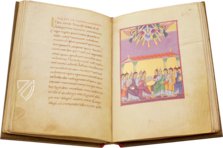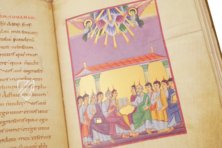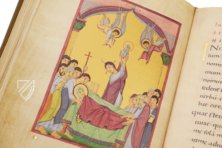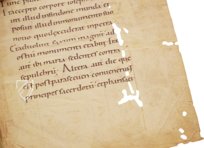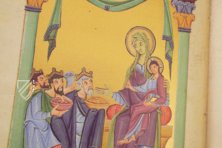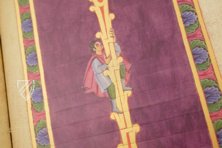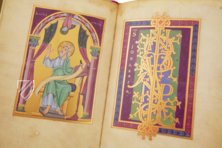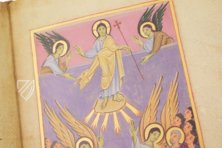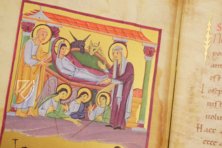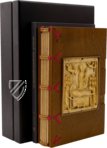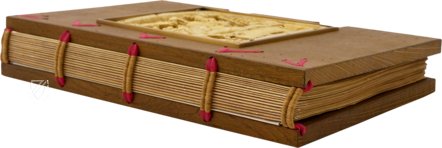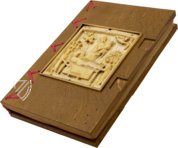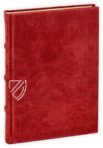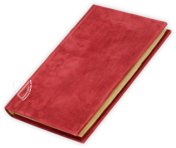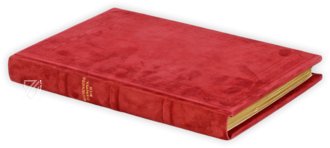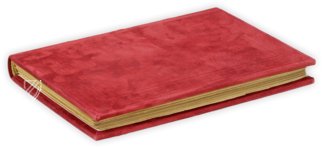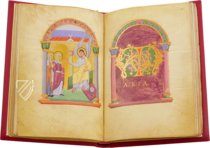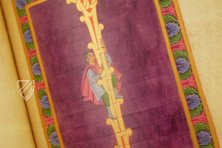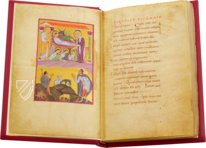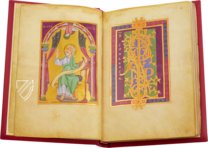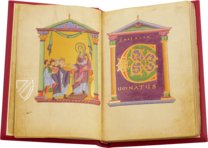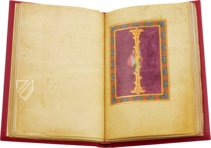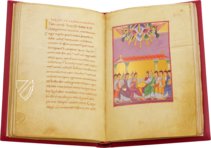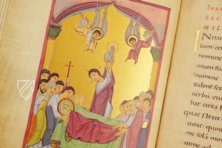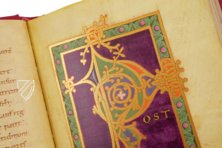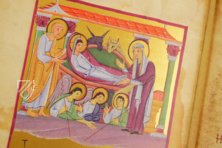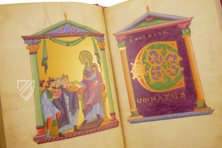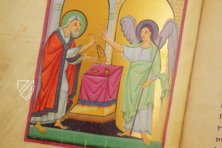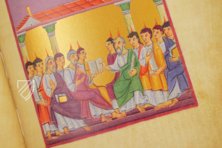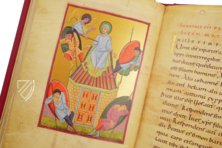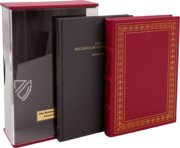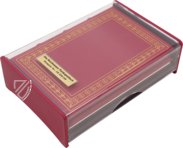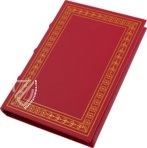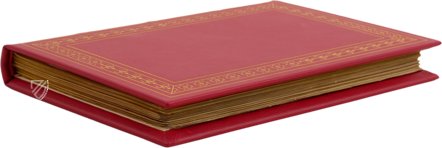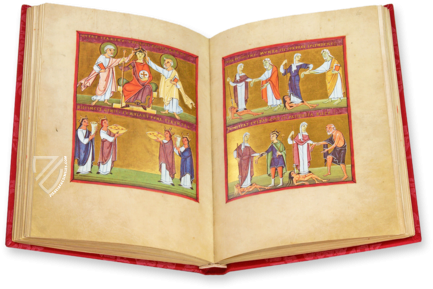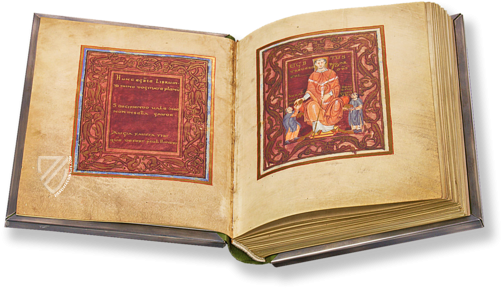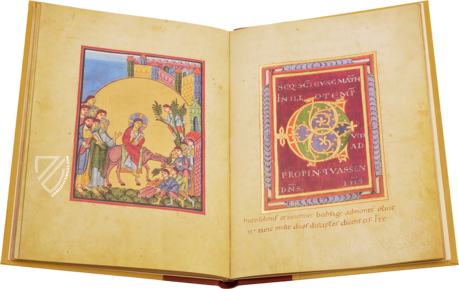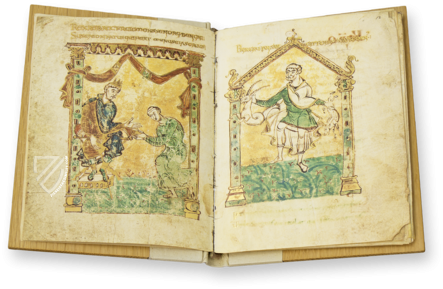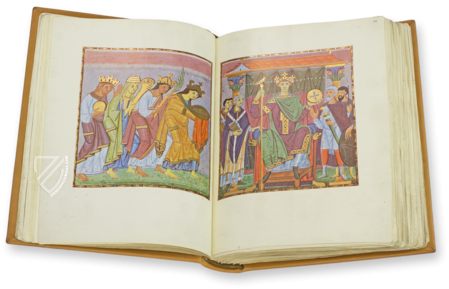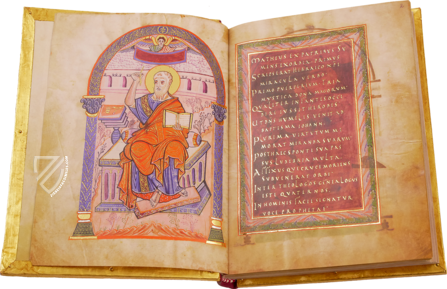Reichenau Pericopes Book
(3,000€ - 7,000€)
The scribes and illuminators of Reichenau Abbey in southern Germany were responsible for some of the greatest manuscripts of the Middle Ages and of the Ottonian period in particular. During the Ottonian age, splendid Reichenau manuscripts were created for high ranking clientele such as Otto III, Henry II, or Egbert, the Archbishop of Trier. The Reichenau Pericopes Book is one of the most impressive and beautiful manuscripts to be held today in the Herzog August Library in Wolfenbüttel, where it is guarded like a public treasury – and rightfully so. Likely created on order of the German Emperor Henry II, its unique beauty lies in its captivatingly rich use of magenta and gold throughout. The manuscript was likely donated by the Emperor to the monastery at Hildesheim after its archives were gutted by a fire on January 20th, 1013.
Reichenau Pericopes Book
Hardly any epoch in the history of book painting has produced such impressive and magnificent manuscripts as the Ottonian age. Among these, a scriptorium stands out above all others in a time when book painters created codices of unsurpassable technical skill and beauty: the scriptorium of Reichenau Abbey. The Reichenau Pericopes Book is one of the most impressive and beautiful manuscripts to be held today in the Herzog August Library in Wolfenbüttel, where it is guarded like a public treasury – and rightfully so. Likely created on order of the German Emperor Henry II, its unique beauty lies in its captivatingly rich use of magenta and gold throughout. The Reichenau Pericopes Book is unique and singular amongst the entire collection of German illumination from the Middle Ages, not only artistically but as well through its use of graphic icons, its nine incomparable pages of miniatures, and six splendiferous pages of decorated initials.
A Golden Pericopes Book
The manuscript in Wolfenbüttel is an evangeliary: The 109 readings (Pericopes) originate exclusively from the four gospels and are arranged in a reading sequence according to the Christian years. Certain highly important ones are illustrated in altogether nine full-page miniatures, which captivate through the expressive use of rich gold gilding and radiant colors. In addition, there are six full-pages of decorative initials, whose large ornamentally arranged design emphasize and introduce selected readings. The unbelievable colors of the decorative elements which contain an abundance of imperial magenta and the finest gold borders, not to mention the generous body of text and numerous golden text initials, all provide a testimony to the high requirement standard of this manuscript.
An Unbelievable Work of Creative Power at the Zenith of German Book Painting
The evangeliary in Wolfenbüttel originated approximately 1000 years ago in the scriptorium of the Benedictine monastery at Reichenau. During the Ottonian age, splendid Reichenau manuscripts were created for high ranking clientele such as Otto III, Henry II, or Egbert, the Archbishop of Trier. The preserved collection of Reichenau works ranks amongst the most precious and impressive expressions of art during the Middle Ages.
The Miniatures: Radiant Gold and Imperial Magenta Created with Unparalleled Skill
The miniatures in the Reichenau Pericopes Book are painted on a vibrant gold base using opaque colors which have not lost any of their original charm. The series of pictures begins with a representation of the birth of Christ and the proclamation of his birth by the shepherds. The adoration of the king somehow connects the large-figured representation of the Virgin Mary holding her child on her lap, with the approaching Three Wise Men from the Orient, who present their gifts in out-stretched arms. A unique combination of pictures and initials rich with figures, provide a reading for Holy Saturday: the most famous miniature features a male figure climbing up the trunk of a large initial "I". Seldom shown is the freeing of Petrus from the dungeon. The picture series is closed by a miniature showing the death and ascension of the Virgin Mary into heaven: a picture theme that was verifiable in Western art only a few years before the emergence of the Reichenau Pericopes Book. Thus our codex represents an absolutely unique work of creative power from the school of Reichenau.
Catastrophic Fire and Chaos of War: Origin and History of the Manuscript
The manuscript was most likely a part of the coronation endowment of Henry II (1002–1024), donated by him on the 26th of March, 1013 during the occasion of his visit to Hildesheim. Hildesheim was hit at the beginning of this year with a catastrophe: on the 20th of January, 1013 it was devastated by a fire, the archive and book inventory of the monastery in particular. This fact may have given cause for the Emperor to endow the monastery with a present in the form of a book. Surely the glorious layout of the Reichenau Pericopes Book with gold and magenta leads one to this assumption. The patron and site of origin of the Reichenau Pericopes Book cannot be verified due to missing sources of information. A hint is provided however – the accentuation of the celebration of the Dead and the Ascension of the Virgin Mary into Heaven: the picture of this celebration (fol. 79v) is prominently displayed and in a splendid ivory carving on the front cover of the book.
An Aristocratic Bibliophile
Duke August the Younger of Braunschweig-Lüneburg (1579–1666), a famous 17th century collector and founder of the now Herzog August Library in Wolfenbüttel, acquired the Reichenau Pericopes Book in 1658, most likely from an unknown collector. The Duke saved large numbers of manuscripts during the occupation of Hildesheim, which had been stolen or pilfered in the course of the 30 Years War. At least seven of these manuscripts originated from the Hildesheim St Michael monastery, whose Patron Saint was the Virgin Mary. Therefore one can assume that the Reichenau Pericopes Book once constituted a main part of the Hildesheim cathedral treasury.
The Ivory Cover: a Unique Work of Art
The wood boards and Byzantine ivory relief carving remain preserved from the original cover of the manuscript. Created ca. 1000, it depicts the death of the Virgin Mary: Mary lies on her death bed, surrounded by apostles. Petrus swings a votive with incense and Paulus mourns while embracing her feet. Christ stands behind the bed, represented in monumental size. In his hands he holds the soul of Mary, depicted as a small puppet-like figure. Flying angels receive the soul and carry it to heaven.
Codicology
- Alternative Titles
- Reichenauer Perikopenbuch
- Size / Format
- 216 pages / 28.0 × 18.5 cm
- Origin
- Germany
- Date
- Beginning of the 11th century
- Epochs
- Style
- Language
- Script
- Carolingian minuscule Uncial Capitals
- Illustrations
- 9 miniatures, 6 full-page initials and numerous golden initials
- Content
- Book of Pericopes
- Patron
- Holy Roman Emperor Henry II (972–1024)
- Previous Owners
- Duke August the Younger of Braunschweig-Lüneburg (1579–1666), founder of the Herzog August Library in Wolfenbüttel (Germany)
Reichenau Pericopes Book
Decorative “P” Initial
This magnificent swirl of tendrils is typical of the fine works of Ottonian art that were produced at Reichenau monastery: bright shades of green, orange, and gold leaf wonderfully contrasted by a purple background. The initial is intertwined with the classically-styled frame filled with acanthus leaves and pink pearls as though it were actually made of growing vines. The remarkably well preserved state of this thousand-year-old work of art is a testament to the quality of the materials used.
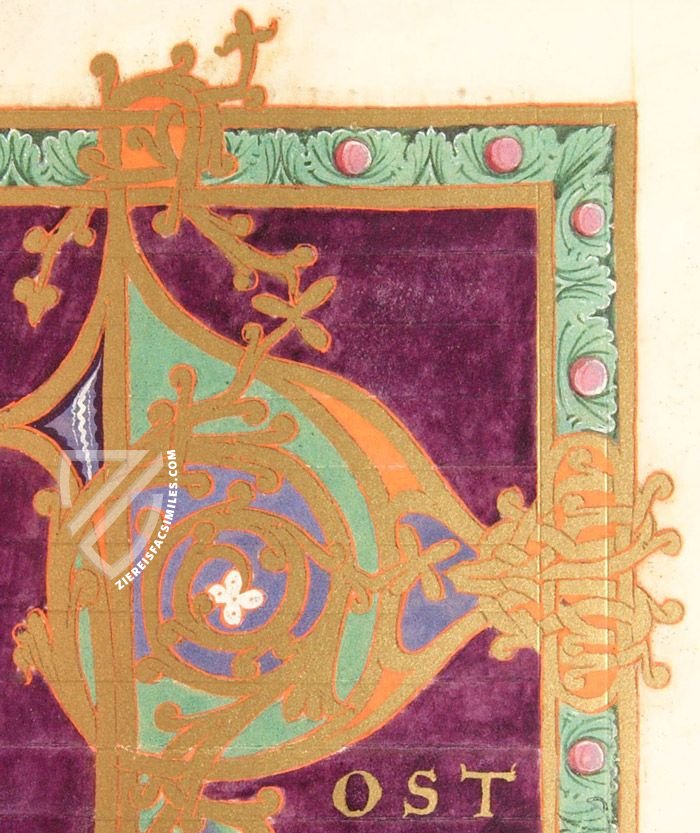
Reichenau Pericopes Book
Outpouring of the Holy Spirit
This miniatures is a wonderful depiction of Pentecost, when the Holy Spirit descended upon the Twelve Apostles as described in the Book of Acts. This event is traditionally regarded as the birth of the early Church. The present depiction of the Pentecost also represents an archetypal Ottonian miniature.
Classical robes and architecture, expressive gestures and piercing eyes, purple paint and gold leaf – this miniature has all the hallmarks of Ottonian illumination. Colored stripes of magenta and gold help to divide Heaven and Earth in typical Ottonian fashion. Unlike later compositions, the Holy Spirit is not represented by a dove, but simply by rays of gold leaf radiating from clouds of red, blue, and green that are flanked by angels.
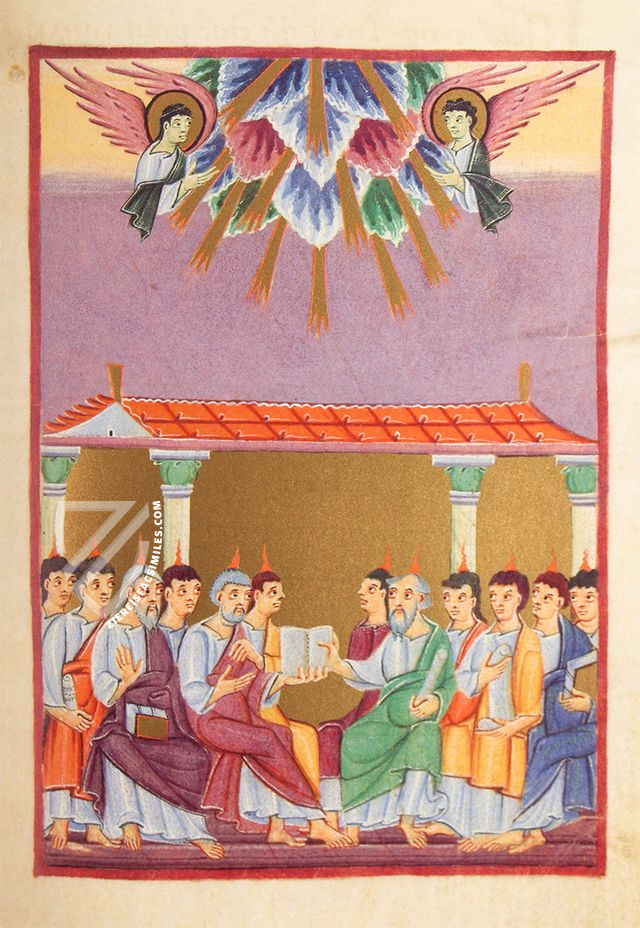
#1 Das Reichenauer Perikopenbuch (Luxury Edition)
Language: German
(3,000€ - 7,000€)
#2 Das Reichenauer Perikopenbuch (Normal Edition)
Language: German
(1,000€ - 3,000€)
#3 Das Reichenauer Perikopenbuch (Normal Edition)
Language: German
(1,000€ - 3,000€)
- Treatises / Secular Books
- Apocalypses / Beatus
- Astronomy / Astrology
- Bestiaries
- Bibles / Gospels
- Chronicles / History / Law
- Geography / Maps
- Saints' Lives
- Islam / Oriental
- Judaism / Hebrew
- Single Leaf Collections
- Leonardo da Vinci
- Literature / Poetry
- Liturgical Manuscripts
- Medicine / Botany / Alchemy
- Music
- Mythology / Prophecies
- Psalters
- Other Religious Books
- Games / Hunting
- Private Devotion Books
- Other Genres
- Afghanistan
- Armenia
- Austria
- Belgium
- Belize
- Bosnia and Herzegovina
- China
- Colombia
- Costa Rica
- Croatia
- Cyprus
- Czech Republic
- Denmark
- Egypt
- El Salvador
- Ethiopia
- France
- Germany
- Greece
- Guatemala
- Honduras
- Hungary
- India
- Iran
- Iraq
- Israel
- Italy
- Japan
- Jordan
- Kazakhstan
- Kyrgyzstan
- Lebanon
- Liechtenstein
- Luxembourg
- Mexico
- Morocco
- Netherlands
- Palestine
- Panama
- Peru
- Poland
- Portugal
- Romania
- Russia
- Serbia
- Spain
- Sri Lanka
- Sweden
- Switzerland
- Syria
- Tajikistan
- Turkey
- Turkmenistan
- Ukraine
- United Kingdom
- United States
- Uzbekistan
- Vatican City
- A. Oosthoek, van Holkema & Warendorf
- Aboca Museum
- Ajuntament de Valencia
- Akademie Verlag
- Akademische Druck- u. Verlagsanstalt (ADEVA)
- Aldo Ausilio Editore - Bottega d’Erasmo
- Alecto Historical Editions
- Alkuin Verlag
- Almqvist & Wiksell
- Amilcare Pizzi
- Andreas & Andreas Verlagsbuchhandlung
- Archa 90
- Archiv Verlag
- Archivi Edizioni
- Arnold Verlag
- ARS
- Ars Magna
- ArtCodex
- AyN Ediciones
- Azimuth Editions
- Badenia Verlag
- Bärenreiter-Verlag
- Belser Verlag
- Belser Verlag / WK Wertkontor
- Benziger Verlag
- Bernardinum Wydawnictwo
- BiblioGemma
- Biblioteca Apostolica Vaticana (Vaticanstadt, Vaticanstadt)
- Bibliotheca Palatina Faksimile Verlag
- Bibliotheca Rara
- Boydell & Brewer
- Bramante Edizioni
- Bredius Genootschap
- Brepols Publishers
- British Library
- C. Weckesser
- Caixa Catalunya
- Canesi
- CAPSA, Ars Scriptoria
- Caratzas Brothers, Publishers
- Carus Verlag
- Casamassima Libri
- Centrum Cartographie Verlag GmbH
- Chavane Verlag
- Christian Brandstätter Verlag
- Circulo Cientifico
- Club Bibliófilo Versol
- Club du Livre
- CM Editores
- Collegium Graphicum
- Collezione Apocrifa Da Vinci
- Comissão Nacional para as Comemorações dos Descobrimentos Portugueses
- Coron Verlag
- Corvina
- CTHS
- D. S. Brewer
- Damon
- De Agostini/UTET
- De Nederlandsche Boekhandel
- De Schutter
- Deuschle & Stemmle
- Deutscher Verlag für Kunstwissenschaft
- DIAMM
- Droz
- E. Schreiber Graphische Kunstanstalten
- Ediciones Boreal
- Ediciones Grial
- Ediclube
- Edições Inapa
- Edilan
- Editalia
- Edition Deuschle
- Edition Georg Popp
- Edition Leipzig
- Edition Libri Illustri
- Editiones Reales Sitios S. L.
- Éditions de l'Oiseau Lyre
- Editions Medicina Rara
- Editorial Casariego
- Editorial Mintzoa
- Editrice Antenore
- Editrice Velar
- Edizioni Edison
- Egeria, S.L.
- Eikon Editores
- Electa
- Emery Walker Limited
- Enciclopèdia Catalana
- Eos-Verlag
- Ephesus Publishing
- Ernst Battenberg
- Eugrammia Press
- Extraordinary Editions
- Fackelverlag
- Facsimila Art & Edition
- Facsimile Editions Ltd.
- Facsimilia Art & Edition Ebert KG
- Faksimile Verlag
- Feuermann Verlag
- Folger Shakespeare Library
- Franco Cosimo Panini Editore
- Friedrich Wittig Verlag
- Fundación Hullera Vasco-Leonesa
- G. Braziller
- Gabriele Mazzotta Editore
- Gebr. Mann Verlag
- Gesellschaft für graphische Industrie
- Getty Research Institute
- Giovanni Domenico de Rossi
- Giunti Editore
- Graffiti
- Grafica European Center of Fine Arts
- Guido Pressler
- Guillermo Blazquez
- Gustav Kiepenheuer
- H. N. Abrams
- Harrassowitz
- Harvard University Press
- Helikon
- Hendrickson Publishers
- Henning Oppermann
- Herder Verlag
- Hes & De Graaf Publishers
- Hoepli
- Holbein-Verlag
- Houghton Library
- Hugo Schmidt Verlag
- Idion Verlag
- Il Bulino, edizioni d'arte
- ILte
- Imago
- Insel Verlag
- Insel-Verlag Anton Kippenberger
- Instituto de Estudios Altoaragoneses
- Instituto Nacional de Antropología e Historia
- Introligatornia Budnik Jerzy
- Istituto dell'Enciclopedia Italiana - Treccani
- Istituto Ellenico di Studi Bizantini e Postbizantini
- Istituto Geografico De Agostini
- Istituto Poligrafico e Zecca dello Stato
- Italarte Art Establishments
- Jan Thorbecke Verlag
- Johnson Reprint Corporation
- Josef Stocker
- Josef Stocker-Schmid
- Jugoslavija
- Karl W. Hiersemann
- Kasper Straube
- Kaydeda Ediciones
- Kindler Verlag / Coron Verlag
- Kodansha International Ltd.
- Konrad Kölbl Verlag
- Kurt Wolff Verlag
- La Liberia dello Stato
- La Linea Editrice
- La Meta Editore
- Lambert Schneider
- Landeskreditbank Baden-Württemberg
- Leo S. Olschki
- Les Incunables
- Liber Artis
- Library of Congress
- Libreria Musicale Italiana
- Lichtdruck
- Lito Immagine Editore
- Lumen Artis
- Lund Humphries
- M. Moleiro Editor
- Maison des Sciences de l'homme et de la société de Poitiers
- Manuscriptum
- Martinus Nijhoff
- Maruzen-Yushodo Co. Ltd.
- MASA
- Massada Publishers
- McGraw-Hill
- Metropolitan Museum of Art
- Militos
- Millennium Liber
- Müller & Schindler
- Nahar - Stavit
- Nahar and Steimatzky
- National Library of Wales
- Neri Pozza
- Nova Charta
- Oceanum Verlag
- Odeon
- Orbis Mediaevalis
- Orbis Pictus
- Österreichische Staatsdruckerei
- Oxford University Press
- Pageant Books
- Parzellers Buchverlag
- Patrimonio Ediciones
- Pattloch Verlag
- PIAF
- Pieper Verlag
- Plon-Nourrit et cie
- Poligrafiche Bolis
- Presses Universitaires de Strasbourg
- Prestel Verlag
- Princeton University Press
- Prisma Verlag
- Priuli & Verlucca, editori
- Pro Sport Verlag
- Propyläen Verlag
- Pytheas Books
- Quaternio Verlag Luzern
- Reales Sitios
- Recht-Verlag
- Reichert Verlag
- Reichsdruckerei
- Reprint Verlag
- Riehn & Reusch
- Roberto Vattori Editore
- Rosenkilde and Bagger
- Roxburghe Club
- Salerno Editrice
- Saltellus Press
- Sandoz
- Sarajevo Svjetlost
- Schöck ArtPrint Kft.
- Schulsinger Brothers
- Scolar Press
- Scrinium
- Scripta Maneant
- Scriptorium
- Shazar
- Siloé, arte y bibliofilia
- SISMEL - Edizioni del Galluzzo
- Sociedad Mexicana de Antropología
- Société des Bibliophiles & Iconophiles de Belgique
- Soncin Publishing
- Sorli Ediciones
- Stainer and Bell
- Studer
- Styria Verlag
- Sumptibus Pragopress
- Szegedi Tudomànyegyetem
- Taberna Libraria
- Tarshish Books
- Taschen
- Tempus Libri
- Testimonio Compañía Editorial
- Thames and Hudson
- The Clear Vue Publishing Partnership Limited
- The Facsimile Codex
- The Folio Society
- The Marquess of Normanby
- The Richard III and Yorkist History Trust
- Tip.Le.Co
- TouchArt
- TREC Publishing House
- TRI Publishing Co.
- Trident Editore
- Tuliba Collection
- Typis Regiae Officinae Polygraphicae
- Union Verlag Berlin
- Universidad de Granada
- University of California Press
- University of Chicago Press
- Urs Graf
- Vallecchi
- Van Wijnen
- VCH, Acta Humaniora
- VDI Verlag
- VEB Deutscher Verlag für Musik
- Verlag Anton Pustet / Andreas Verlag
- Verlag Bibliophile Drucke Josef Stocker
- Verlag der Münchner Drucke
- Verlag für Regionalgeschichte
- Verlag Styria
- Vicent Garcia Editores
- W. Turnowski Ltd.
- W. Turnowsky
- Waanders Printers
- Wiener Mechitharisten-Congregation (Wien, Österreich)
- Wissenschaftliche Buchgesellschaft
- Wissenschaftliche Verlagsgesellschaft
- Wydawnictwo Dolnoslaskie
- Xuntanza Editorial
- Zakład Narodowy
- Zollikofer AG

